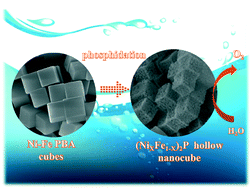Bimetallic phosphide hollow nanocubes derived from a prussian-blue-analog used as high-performance catalysts for the oxygen evolution reaction†
Abstract
The development of efficient and stable electrocatalysts for the oxygen evolution reaction (OER) based on earth-abundant materials is of significance to enable water splitting as a feasible source of alternative energy. Metal–organic frameworks (MOFs) have been intensively employed as the templates/precursors to synthesize catalysts with hollow structures for various energy-related applications. In this study, using MOF (Ni–Fe prussian-blue-analog) as a template and precursor, a novel and promising bimetallic phosphide catalyst (Ni0.62Fe0.38)2P was obtained. Benefiting from synergistic effect between the Ni and Fe species, well-defined architecture and high surface area the as-made (Ni0.62Fe0.38)2P hollow nanocubes show a remarkable electrocatalytic performance for the OER in 1 M KOH electrolyte with a low overpotential of only 290 mV at a current density of 10 mA cm−2 and a small Tafel slope of 44 mV per decade, which even surpass the benchmark IrO2 catalyst. Moreover, the (Ni0.62Fe0.38)2P hollow nanocubes exhibit good long-term stability. This facile and novel route to prepare bimetallic phosphide hollow nanocubes as active OER catalysts broadens the scope for designing other noble-metal-free OER efficient catalysts for electrochemical water splitting in the future.



 Please wait while we load your content...
Please wait while we load your content...